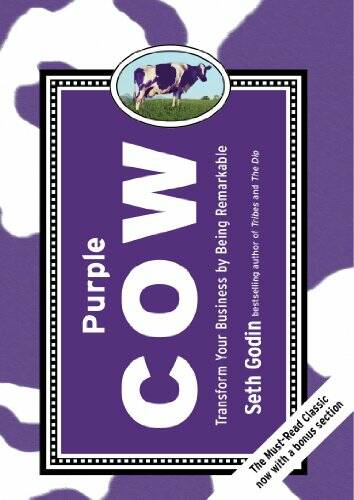Purple Cow
The essence of this book is that your product or service must be remarkable. It’s about the why, the what, and the how of remarkable.

Transform your business by being remarkable.
The essence of this book is that your product or service must be remarkable. It’s about the why, the what, and the how of remarkable.
Remarkable marketing is the art of building things worth noticing right into your product or service. Not slapping on marketing as a last-minute add-on, but understanding that if your offering itself isn’t remarkable, it’s invisible.
The old rule of marketing was “Create safe, ordinary products and combine them with great marketing”. The new rule is “Create remarkable products that the right people seek out”.
How do you create an idea that spreads?
Don’t try to make a product for everybody, because that is a product for nobody.
The way you break through to the mainstream is to target a niche instead of a huge market. With a niche, you can segment off a chunk of the mainstream, and create an Ideavirus so focused that it overwhelms that small slice of the market that really and truly will respond to what you sell.
The early adopters in this market niche are more eager to hear what you have to say. The sneezers in this market niche are more likely to talk about your product. And best of all, the market is small enough that a few sneezers can get you to the critical mass you need to create an Ideavirus.
Not all customers are the same
Differentiate your customers. Find the group that’s most profitable. Find the group that’s most likely to sneeze. Figure out how to develop/advertise/reward either group. Ignore the rest.
Your ads (and your products!) shouldn’t cater to the masses. Your ads (and products) should cater to the customers you’d choose if you could choose your customers.
How to be remarkable?
Remarkable isn’t always about changing the biggest machine in your factory. It can be the way you answer the phone, launch a new brand, or price a revision to your software.
Getting in the habit of doing the “unsafe” thing every time you have the opportunity is the best way to learn to project—you get practice at seeing what’s working and what’s not.
Explore the limits.
What if you’re the cheapest, the fastest, the slowest, the hottest, the coldest, the easiest, the most efficient, the loudest, the most hated, the copycat, the outsider, the hardest, the oldest, the newest, the . . . most!
If there’s a limit, you should (must) test it.
Think small.
One vestige of the TV-INDUSTRIAL complex is a need to think mass. If it doesn’t appeal to everyone, the thinking goes, it’s not worth it. No longer.
Think of the smallest conceivable market, and create a product that overwhelms it with its remarkability. Go from there.
Outsource.
If the factory is giving you a hard time about jazzing up the product, go elsewhere. There are plenty of job shops that would be delighted to take on your product. After it works, the factory will probably be happy to take the product back.
Build and use a permission asset.
Once you have the ability to talk directly to your most loyal customers, it gets much easier to develop and sell amazing things. Without the filters of advertising, wholesalers, and retailers, you can create products that are far more remarkable.
Copy.
Not from your industry, but from any other industry. Find an industry duller than yours, discover who’s remarkable (it won’t take long), and do what they did.
Ask, “Why not?”
Almost everything you don’t do has no good reason for it. Almost everything you don’t do is the result of fear or inertia or a historical lack of someone asking, “Why not?”